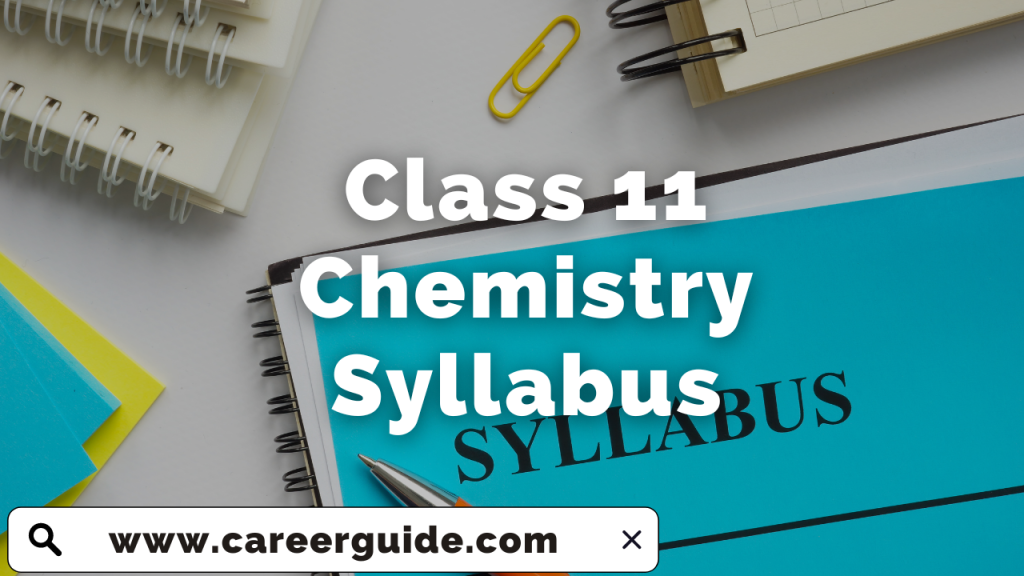Embarking on the academic odyssey of Class 11 Chemistry brings forth the gateway to understanding the fundamental principles that govern matter and its transformations. The Class 11 Chemistry Syllabus is not merely a collection of chemical reactions and equations; it is a comprehensive guide that intricately details the diverse facets of this captivating science. This introduction serves as a portal into the details, importance, and preparation strategies associated with the syllabus, offering students a roadmap to navigate the intricacies of chemical structures, reactions, and theories. As we delve into the realms of organic, inorganic, and physical chemistry, the goal is to illuminate the significance of each module, paving the way for an insightful and well-prepared academic journey.
- Introduction
- CBSE Class 11 Chemistry Syllabus 2023-24
- CBSE Class 11 Chemistry Syllabus 2023-24 for Theory
- CBSE Class 11 Chemistry Syllabus 2023-24 for Practical
- Unit-wise CBSE Class 11 Chemistry Syllabus 2023-24
- Chemistry Syllabus 2023-24 Question paper design
- Deleted chapters in CBSE Class 11 Chemistry Syllabus
- Conclusion
- FAQ’s
- Introduction
Exploring Foundations: Overview of Class 11 Chemistry Syllabus
Unlocking the Molecular Tapestry: Syllabus Details
As students step into Class 11 Chemistry, they are greeted with a rich tapestry of chemical concepts, reactions, and principles. The Class 11 Chemistry Syllabus serves as a detailed map, guiding them through the realms of physical chemistry, organic chemistry, and inorganic chemistry. From understanding atomic structures to exploring the intricacies of chemical bonding and reactions, this section will delve into the specific chapters and modules that form the foundation of this academic journey.
The Crucial Significance: Why Class 11 Chemistry Matters Class 11
Chemistry is more than a subject; it’s a fundamental building block for future scientific endeavors. Recognizing its importance goes beyond examinations; it lays the groundwork for advanced studies and real-world applications. This segment will illuminate the crucial significance of each topic in shaping a comprehensive understanding of the molecular world, fostering analytical thinking and problem-solving skills essential for future scientific exploration.
Strategies for Success: Navigating Class 11 Chemistry Preparation
As students prepare to delve into the intricacies of Class 11 Chemistry, effective preparation strategies become paramount. This part will unfold tips and insights into mastering theoretical concepts, leveraging practical experiments, and utilizing study resources. By understanding the weightage of each section and adopting targeted study approaches, students can embark on their Class 11 Chemistry journey with confidence, ensuring not just success in examinations but a profound grasp of the scientific principles that will accompany them in future academic pursuits.

CBSE Class 11 Chemistry Syllabus 2023-24
CBSE Class 11 Chemistry Syllabus 2023-24
Embarking on the academic journey of Class 11 Chemistry under the CBSE curriculum unveils a comprehensive syllabus designed to shape students’ understanding of the molecular world. In the academic year 2023-24, the CBSE Class 11 Chemistry Syllabus takes center stage, providing a structured framework that encompasses the diverse branches of chemistry – physical, organic, and inorganic. From atomic structures to complex chemical reactions, this syllabus serves as a roadmap, guiding students through an engaging exploration of foundational concepts that will set the stage for advanced scientific studies.
Key Highlights of CBSE Class 11 Chemistry Syllabus 2023-24:
- Physical Chemistry: Comprehensive coverage of thermodynamics, equilibrium, and chemical kinetics.
- Organic Chemistry: In-depth study of hydrocarbons, biomolecules, and polymers.
- Inorganic Chemistry: Exploration of the periodic table, coordination compounds, and chemical bonding.
- Practical Component: Emphasis on hands-on experimentation to reinforce theoretical knowledge.
- Importance of Each Module: Understanding the weightage of topics for strategic study planning.
CBSE Class 11 Chemistry Syllabus 2023-24 for Theory
The marking method will assist students in comprehending the centrality of each subject in the CBSE Class 11 Chemistry Syllabus 2023-24. This will help understudies in planning for and confronting the examinations. The CBSE class 11 chemistry (theoretical) test will be worth 70 marks. Understudies may utilize the chapter-by-chapter stamping framework to plan for the exam.
| Marks Distribution of CBSE Class 11 Chemistry Syllabus 2023-24 for Theory | ||
| Unit | No. of Periods | Marks |
| Some Basic Concepts of Chemistry | 18 | 7 |
| Structure of Atom | 20 | 9 |
| Classification of Elements and Periodicity in Properties | 12 | 6 |
| Chemical Bonding and Molecular Structure | 20 | 7 |
| Chemical Thermodynamics | 23 | 9 |
| Equilibrium | 20 | 7 |
| Redox Reactions | 9 | 4 |
| Organic Chemistry: Some Basic Principles and Techniques | 20 | 11 |
| Hydrocarbons | 18 | 10 |
| Total | 160 | 70 |
CBSE Class 11 Chemistry Syllabus 2023-24 for Practical
The practical examination will be worth thirty marks. To pass this test, students must do viable tests. The taking after is the examination assessment scheme:
| Marks Distribution of CBSE Class 11 Chemistry Syllabus 2023-24 for Practical | |
| Evaluation Scheme for Examination | Marks |
| Volumetric Analysis | 08 |
| Salt Analysis | 08 |
| Content-Based Experiment | 06 |
| Project work | 04 |
| Class record and viva | 05 |
| Total | 30 |
Unit-wise CBSE Class 11 Chemistry Syllabus 2023-24
The CBSE Class 11 Chemistry Syllabus 2023-24 has been made in such a way that students will understand the essentials and will not have any troubles in Class 12th. The CBSE 11th Chemistry Syllabus 2023-24 is accessible here, at the side the official PDF. Understudies ought to go over all of the chapters in the CBSE Class 11 Chemistry Syllabus 2023-24 and work to cover them all before the tests.
| Unit-wise CBSE Class 11 Chemistry Syllabus 2023-24 | ||
| Unit | Chapter | Topics |
| I. | Some Basic Concepts of Chemistry | General Introduction: Importance and scope of Chemistry. Nature of matter, laws of chemical combination, Dalton’s atomic theory: the concept of elements, atoms, and molecules. Atomic and molecular masses, mole concept and molar mass, percentage composition, empirical and molecular formula, chemical reactions, stoichiometry, and calculations based on stoichiometry. |
| II. | Structure of Atom | Discovery of Electron, Proton and Neutron, atomic number, isotopes and isobars. Thomson’s model and its limitations. Rutherford’s model and its limitations, Bohr’s model and its limitations, concept of shells and subshells, dual nature of matter and light, de Broglie’s relationship, Heisenberg uncertainty principle, concept of orbitals, quantum numbers, shapes of s, p and d orbitals, rules for filling electrons in orbitals – Aufbau principle, Pauli’s exclusion principle and Hund’s rule, electronic configuration of atoms, stability of half-filled and filled orbitals. |
| III. | Classification of Elements and Periodicity in Properties | Significance of classification, a brief history of the development of the periodic table, modern periodic law and the present form of the periodic table, periodic trends in properties of elements -atomic radii, ionic radii, inert gas radii, Ionization enthalpy, electron gain enthalpy, electronegativity, valency. Nomenclature of elements with atomic number greater than 100. |
| IV. | Chemical Bonding and Molecular Structure | Valence electrons, ionic bond, covalent bond, bond parameters, Lewis’s structure, polar character of covalent bond, covalent character of ionic bond, valence bond theory, resonance, geometry of covalent molecules, VSEPR theory, concept of hybridization, involving s, p and d orbitals and shapes of some simple molecules, molecular orbital theory of homonuclear diatomic molecules (qualitative idea only), Hydrogen bond. |
| V. | Chemical Thermodynamics | Concepts of Systems and types of systems, surroundings, work, heat, energy, extensive and intensive properties, and state functions. The first law of thermodynamics -internal energy and enthalpy, heat capacity and specific heat, measurement of ΔU and ΔH, Hess’s law of constant heat summation, enthalpy of bond dissociation, combustion, formation, atomization, sublimation, phase transition, ionization, solution and dilution. The second law of Thermodynamics (brief introduction) Introduction of entropy as a state function, Gibb’s energy change for spontaneous and non-spontaneous processes, and criteria for equilibrium. Third law of thermodynamics (brief introduction). |
| VI. | Equilibrium | Equilibrium in physical and chemical processes, dynamic nature of equilibrium, the law of mass action, equilibrium constant, factors affecting equilibrium – Le Chatelier’s principle, ionic equilibrium- ionization of acids and bases, strong and weak electrolytes, degree of ionization, ionization of polybasic acids, acid strength, the concept of pH, hydrolysis of salts (elementary idea), buffer solution, Henderson Equation, solubility product, common ion effect (with illustrative examples). |
| VII. | Redox Reactions | Concept of oxidation and reduction, redox reactions, oxidation number, balancing redox reactions, in terms of loss and gain of electrons and change in oxidation number, applications of redox reactions. |
| VIII. | Organic Chemistry -Some Basic Principles and Techniques | General introduction, methods of purification, qualitative and quantitative analysis, classification and IUPAC nomenclature of organic compounds. Electronic displacements in a covalent bond: inductive effect, electromeric effect, resonance and hyperconjugation. Homolytic and heterolytic fission of a covalent bond: free radicals, carbocations, carbanions, electrophiles and nucleophiles, types of organic reactions. |
| IX. | Hydrocarbons: Classification of Hydrocarbons Aliphatic Hydrocarbons: | Alkanes – Nomenclature, isomerism, conformation (ethane only), physical properties, chemical reactions including free radical mechanism of halogenation, combustion and pyrolysis. Alkenes – Nomenclature, the structure of double bond (ethene), geometrical isomerism, physical properties, methods of preparation, chemical reactions: addition of hydrogen, halogen, water, hydrogen halides (Markovnikov’s addition and peroxide effect), ozonolysis, oxidation, mechanism of electrophilic addition. Alkynes – Nomenclature, the structure of triple bond (ethyne), physical properties, methods of preparation, chemical reactions: acidic character of alkynes, addition reaction of – hydrogen, halogens, hydrogen halides, and water. Aromatic Hydrocarbons: Introduction, IUPAC nomenclature, benzene: resonance, aromaticity, chemical properties: mechanism of electrophilic substitution. Nitration, sulphonation, halogenation, Friedel Craft’s alkylation and acylation, directive influence of the functional group in monosubstituted benzene. Carcinogenicity and toxicity. |
Chemistry Syllabus 2023-24 Question paper design
The table below consists of the CBSE Class 11 chemistry question paper design.
| CBSE Class 11 Chemistry Syllabus 2023-24 Question paper design | ||
| Domain | Marks | Percentage |
Remembering and Understanding: Exhibit memory of previously learned material by recalling facts, terms, basic concepts, and answers. Demonstrate understanding of facts and ideas by organizing, comparing, translating, interpreting, giving descriptions, and stating main ideas | 28 | 40 |
| Applying: Solve problems to new situations by applying acquired knowledge, facts, techniques, and rules in a different way. | 21 | 30 |
Analysing, Evaluating and Creating: Examine and break information into parts by identifying motives or causes. Make inferences and find evidence to support generalisations. Present and defend opinions by making judgments about information, validity of ideas, or quality of work based on a set of criteria. Compile information together in a different way by combining elements in a new pattern or proposing alternative solutions. | 21 | 3 |
Deleted chapters in CBSE Class 11 Chemistry Syllabus
The units listed below are the ultimate Chemistry units for the 2023-24 Class 11 Science batch. But for two, the lion’s share of the units contain the same content. The subjects presented to the CBSE Class 11 Chemistry Syllabus 2023-24 are listed below.
| Deleted chapters in CBSE Class 11 Chemistry Syllabus 2023-24 | |||
| Unit Number | Chapter Name | Deleted Topics | Added Topics |
| I | Some Basic Concepts of Chemistry | – | – |
| II | Structure of Atom | – | Discovery of Electron, Proton, and Neutron, atomic number, isotopes, and isobars. Thomson’s model and its limitations. Rutherford’s model and its limitations. |
| III | Classification of Elements and Periodicity in Properties | – | Significance of classification, a brief history of the development of the periodic table |
| IV | Chemical Bonding and Molecular Structure | – | – |
| V | Chemical Thermodynamics | – | – |
| VI | Equilibrium | – | – |
| VII | Redox Reactions | – | – |
| VIII | Organic Chemistry: Some Basic Principles and Techniques | – | – |
| IX | Hydrocarbons | – | – |
Get the entire list of chapter-by-chapter subjects removed from the most recent Chemistry NCERT Book for Class 11 CBSE. Previously, the Class 11 Chemistry curriculum contained 14 units, which have subsequently been cut to 9.
In the table below, you can see the titles of the units that were eliminated from the NCERT textbook, as well as the subjects covered in these 5 units.
| Units/Chapters | Deleted Topics | Topics covered in Deleted Units |
| Chemistry – Part I | ||
| Unit V: States of Matter: Gases and Liquids | Complete Chapter | Three states of matter, intermolecular interactions, types of bonding, melting and boiling points, role of gas laws in elucidating the concept of the molecule, Boyle’s law, Charles law, Gay Lussac’s law, Avogadro’s law, ideal behaviour, empirical derivation of gas equation, Avogadro’s number, ideal gas equation. Deviation from ideal behaviour, liquefaction of gases, critical temperature, kinetic energy and molecular speeds (elementary idea) Liquid State: vapour pressure, viscosity and surface tension (qualitative idea only, no mathematical derivations) |
| Chemistry—Part II | ||
| Unit IX: Hydrogen | Complete Chapter | Position of hydrogen in the periodic table, occurrence, isotopes, preparation, properties and uses of hydrogen, hydrides-ionic covalent and interstitial; physical and chemical properties of water, heavy water, hydrogen peroxide – preparation, reactions and structure and use; hydrogen as a fuel. |
| Unit X: s-Block Elements | Complete Chapter | Group 1 and Group 2 Elements General introduction, electronic configuration, occurrence, anomalous properties of the first element of each group, diagonal relationship, trends in the variation of properties (such as ionization enthalpy, atomic and ionic radii), trends in chemical reactivity with oxygen, water, hydrogen and halogens, uses. Preparation and Properties of Some Important Compounds: Sodium Carbonate, Sodium Chloride, Sodium Hydroxide and Sodium hydrogen carbonate, Biological importance of Sodium and Potassium. Calcium Oxide and Calcium Carbonate and their industrial uses, biological importance of Magnesium and Calcium. |
| Unit XI: Some p-Block Elements | Complete Chapter | General Introduction to p -Block Elements Group 13 Elements: General introduction, electronic configuration, occurrence, variation of properties, oxidation states, trends in chemical reactivity, anomalous properties of the first element of the group, Boron – physical and chemical properties, some important compounds, Borax, Boric acid, Boron Hydrides, Aluminium: Reactions with acids and alkalies, uses. Group 14 Elements: General introduction, electronic configuration, occurrence, variation of properties, oxidation states, trends in chemical reactivity, anomalous behaviour of first elements. Carbon-catenation, allotropic forms, physical and chemical properties; uses of some important compounds: oxides. Important compounds of Silicon and a few uses: Silicon Tetrachloride, Silicones, Silicates and Zeolites, their uses. |
| Unit XIV: Environmental Chemistry | Complete Chapter | Environmental pollution – air, water and soil pollution, chemical reactions in the atmosphere, smog, major atmospheric pollutants, acid rain, ozone and its reactions, effects of depletion of the ozone layer, greenhouse effect and global warming- pollution due to industrial wastes, green chemistry as an alternative tool for reducing pollution, strategies for control of environmental pollution. |
Conclusion
Conclusion: Charting Success in Class 11 Chemistry
Unlocking the Mysterious World: A Comprehensive Journey In conclusion,
our exploration of the Class 11 Chemistry Syllabus has unraveled the intricate details of this academic voyage. From the foundational principles of physical chemistry to the nuanced structures of organic compounds and the intriguing world of inorganic elements, each aspect contributes to a holistic understanding of the subject. This journey is not merely about memorizing reactions; it’s about unlocking the mysteries of the molecular world, paving the way for a profound scientific understanding.
The Crucial Significance Beyond Exams: A Key to Future Scientific Prowess
Understanding the importance of Class 11 Chemistry goes beyond the realms of examinations. It forms the bedrock for future scientific endeavors, laying the groundwork for advanced studies and real-world applications. Each chapter holds significance in fostering analytical thinking, problem-solving skills, and a deep appreciation for the principles that govern the chemical world. The knowledge gained in Class 11 becomes a key to unlocking future scientific prowess.
Strategies for Triumph: Navigating Effective Preparation
As students embark on their journey through Class 11 Chemistry, effective preparation strategies stand as the cornerstone of success. Recognizing the weightage of each module, adopting targeted study approaches, and engaging with practical experiments are vital components of this preparation. By navigating the syllabus with strategic insights, students not only ensure success in examinations but also equip themselves with the tools for a lifelong understanding of the scientific principles that will accompany them on their academic odyssey.
FAQ's
The Class 11 Chemistry Syllabus comprises three main branches: Physical Chemistry, Organic Chemistry, and Inorganic Chemistry. Each branch delves into distinct aspects of chemical science.
Physical Chemistry in Class 11 explores foundational concepts such as thermodynamics, equilibrium, and chemical kinetics. These topics lay the groundwork for understanding the physical properties and behavior of matter.
Organic Chemistry introduces students to the diverse world of carbon compounds, including hydrocarbons, biomolecules, and polymers. This branch emphasizes the structures, properties, and reactions of organic compounds.
Inorganic Chemistry covers topics related to the periodic table, chemical bonding, and coordination compounds. It provides insights into the properties and behavior of inorganic elements and compounds.




















